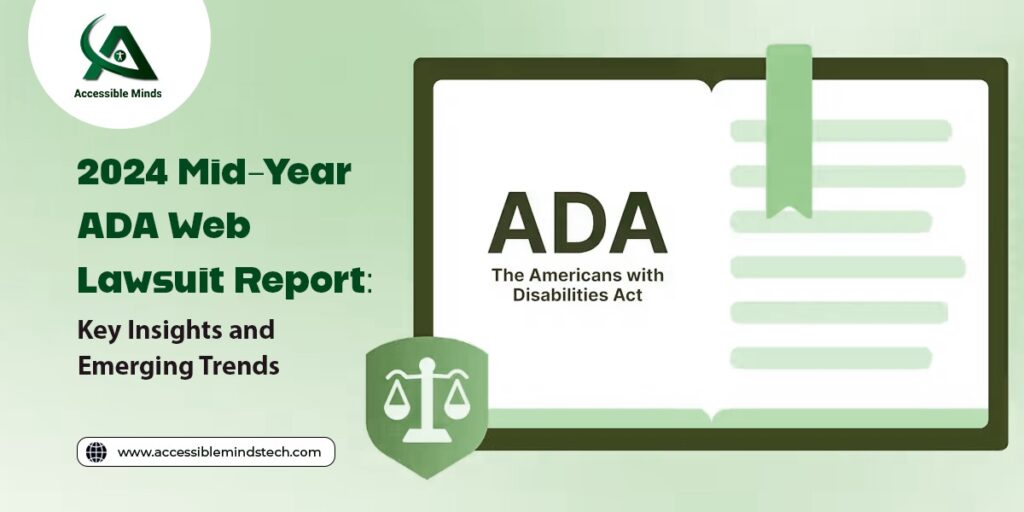As we reach the midpoint of 2024, the landscape of digital accessibility is more critical than ever. The mid-year ADA (Americans with Disabilities Act) web lawsuit report offers a window into the evolving challenges and opportunities faced by businesses and organizations. With a sharp increase in lawsuits related to web accessibility, it’s evident that the demand for digital accessibility services is escalating. In this blog, we’ll delve into key insights and emerging trends from the 2024 report, shedding light on the importance of accessibility in the digital age.
The Rise of Web Accessibility Lawsuits
In 2024, the number of ADA web accessibility lawsuits has surged compared to previous years. This trend is not surprising, given the increasing reliance on digital platforms for everyday activities. From shopping to education to healthcare, the digital realm has become integral to modern life. However, this shift has also highlighted the exclusion faced by individuals with disabilities when websites and apps fail to meet accessibility standards.
Digital accessibility services have become a critical response to this challenge, helping organizations ensure that their digital assets are compliant with the ADA and other relevant guidelines. Companies that invest in these services can mitigate the risk of lawsuits while fostering an inclusive environment for all users.
Key Insights from the 2024 Report
- Increased Awareness and Advocacy: There has been a marked increase in awareness around digital accessibility, driven by advocacy groups and government initiatives. This heightened awareness has empowered individuals with disabilities to assert their rights, leading to a spike in lawsuits against non-compliant websites.
- Focus on E-Commerce and Financial Services: The report highlights that e-commerce and financial services are the sectors most frequently targeted by ADA web accessibility lawsuits. These industries are under scrutiny due to their vast customer base and the critical nature of the services they provide. Businesses in these sectors are increasingly turning to digital accessibility services to ensure that their websites are accessible to everyone, including individuals with disabilities.
- Emerging Legal Precedents: Several recent court rulings have set important precedents in ADA web accessibility cases. For instance, courts are increasingly holding that websites are “places of public accommodation” under the ADA, making them subject to accessibility requirements. These legal developments underscore the need for proactive measures in web accessibility compliance.
- The Role of Automated Testing Tools: As the volume of lawsuits rises, so does the adoption of automated testing tools designed to identify accessibility issues. These tools are becoming more sophisticated, allowing businesses to detect and address potential problems before they lead to litigation. However, while automation plays a significant role, it cannot replace the human element in accessibility testing. A combination of automated tools and expert manual testing remains the best approach to achieving comprehensive accessibility.
- Impact on Small and Medium-Sized Enterprises (SMEs): Small and medium-sized enterprises (SMEs) have not been immune to the surge in ADA web accessibility lawsuits. In fact, SMEs are often more vulnerable due to limited resources and awareness. The 2024 report indicates a growing trend of lawsuits targeting SMEs, which underscores the importance of digital accessibility services tailored to the needs of smaller businesses.
Emerging Trends in Digital Accessibility
- AI and Machine Learning in Accessibility: Artificial intelligence (AI) and machine learning (ML) are increasingly being integrated into accessibility solutions. From AI-driven screen readers to predictive text algorithms that consider accessibility, these technologies are enhancing the user experience for individuals with disabilities. However, the rapid development of AI and ML also presents new challenges, particularly in ensuring that these technologies themselves are accessible and do not introduce new barriers.
- Mobile Accessibility on the Rise: With mobile devices becoming the primary mode of accessing the internet for many users, mobile accessibility is a growing focus. The 2024 report highlights an increase in lawsuits related to mobile apps that fail to meet accessibility standards. Businesses must prioritize mobile accessibility to avoid legal risks and provide a seamless experience for all users.
- Globalization of Accessibility Standards: While the ADA is a U.S.-based law, the principles of digital accessibility are increasingly being adopted worldwide. The 2024 report notes that international organizations are aligning their accessibility standards with the ADA and WCAG (Web Content Accessibility Guidelines), making it essential for businesses with a global presence to ensure compliance across all markets.
- Inclusive Design as a Competitive Advantage: Beyond legal compliance, there is a growing recognition that inclusive design is a competitive advantage. Businesses that prioritize accessibility are not only protecting themselves from lawsuits but also expanding their customer base and enhancing their brand reputation. Digital accessibility services are crucial in helping companies integrate inclusive design principles into their digital assets, creating a more equitable online experience for all users.
Conclusion
The 2024 mid-year ADA web lawsuit report paints a clear picture: digital accessibility is no longer optional. As the number of lawsuits continues to rise, businesses must prioritize accessibility to avoid legal repercussions and build a more inclusive digital landscape. Investing in digital accessibility services is not just a legal necessity but a strategic move that can enhance user experience, broaden market reach, and foster brand loyalty.
In an increasingly digital world, accessibility is key to ensuring that everyone, regardless of ability, can participate fully in society. The trends and insights from the 2024 report serve as a wake-up call for organizations to take digital accessibility seriously and make it a core part of their digital strategy.

